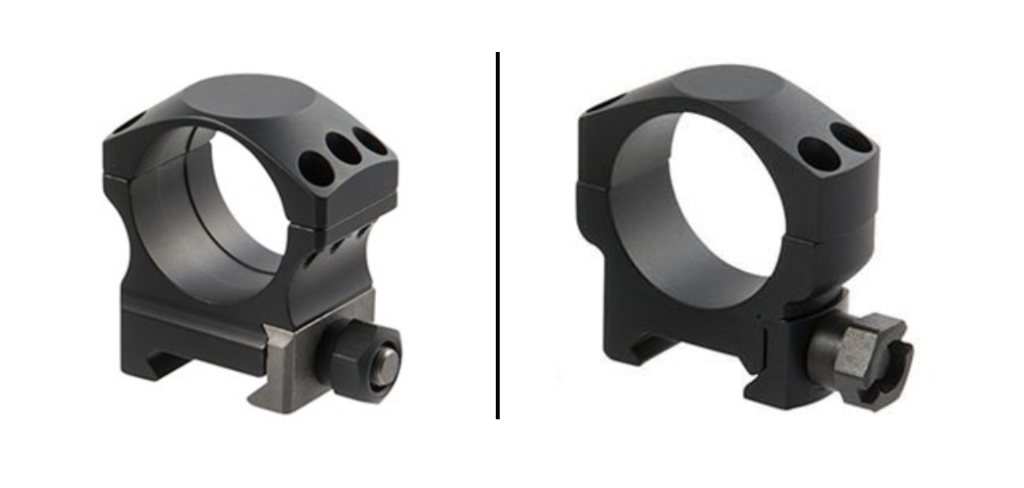When setting up a rifle for hunting, long-range precision, or tactical use, one of the most overlooked yet critical components is your scope rings. Specifically, whether to go with 4-screw or 6-screw scope rings — a decision that can impact your accuracy, optic longevity, and overall shooting confidence.
At first glance, the number of screws might seem like a minor detail. However, the differences between these two styles of rings go far beyond just an extra pair of bolts. In this blog, we’ll break down what separates 4-screw and 6-screw scope rings, explore the advantages and disadvantages of each, and help you decide which is best for your needs.
What Are Scope Ring Screws For?
Before diving into the differences, it’s important to understand the purpose of those screws. Each ring (front and rear) uses screws to clamp the top half of the ring to the bottom, holding the scope tube securely in place.
These screws:
- Prevent the scope from moving under recoil.
- Keep the reticle aligned with your bore.
- Protect the scope tube from stress or damage due to uneven clamping.
So, the number of screws per ring (4 vs 6) simply refers to how many are used to secure each ring cap. This means you’ll typically have a total of 8 or 12 screws across the entire mount setup.
4-Screw Scope Rings
4-screw rings are the most common configuration on the market, with two screws per side of the ring cap (top half). They’ve been the industry standard for decades and are widely used by hunters, recreational shooters, and even some competitive marksmen.
Pros of 4-Screw Rings:
- Lightweight: Fewer screws means less metal, which can be ideal for lightweight hunting or mountain rifles.
- Faster setup: With fewer screws to torque down, installation and scope adjustments are quicker and simpler.
- Sufficient for most calibres: For low to moderate recoil rifles (.22LR to .308), 4-screw rings provide more than enough clamping force.
- Wide availability: Since they are standard, 4-screw rings come in every size, material, height, and price point.
Cons of 4-Screw Rings:
- Less surface area: Four screws apply pressure at fewer points, which may result in slightly less uniform clamping force.
- More prone to movement under recoil: Especially on magnum or high-recoil calibres, they can allow minimal scope shift over time if not properly torqued.
- Slightly less grip: This could be a concern if using large, heavy optics or shooting from awkward angles where the rifle may get knocked around.
6-Screw Scope Rings
6-screw rings feature three screws per side on the top cap, providing six points of contact on each ring. These are designed for heavy-duty use, especially in long-range, tactical, and magnum calibre environments.
Pros of 6-Screw Rings:
- Maximum clamping strength: More screws mean more pressure spread across a wider area of the scope tube, helping prevent any movement from recoil or impact.
- Better suited for large scopes: If you’re running a long, heavy optic (such as a 34mm tube scope with a large objective), 6-screw rings offer better security.
- Ideal for magnum calibres: The additional grip reduces the chances of scope creep under high recoil, which is crucial for cartridges like .300 Win Mag or .338 Lapua.
- Improved durability: Often made for tactical or long-range use, these rings are typically overbuilt and designed to withstand abuse.
Cons of 6-Screw Rings:
- Heavier: More metal and more hardware means added weight — not ideal for ultralight rifle builds.
- Slower installation: With 12 screws to torque and evenly tighten, installation takes longer and requires more care to ensure proper alignment and torque.
- More expensive: Generally speaking, 6-screw rings come at a higher price point due to the added material and more robust design.
Which Is Better?
There’s no one-size-fits-all answer — it depends on your rifle, optic, shooting discipline, and personal preferences. Here’s a breakdown to guide your decision:
Choose 4-Screw Rings If You:
- Are building a lightweight hunting rifle or rimfire setup.
- Shoot moderate recoil calibres like .223, .243, or .308.
- Want a budget-friendly and simple mounting solution.
- Need quick installation or frequent optic swaps.
Choose 6-Screw Rings If You:
- Shoot magnum or high-recoil calibres.
- Use a heavy, high-magnification optic.
- Compete in precision rifle or long-range tactical shooting.
- Want maximum scope security and peace of mind in the field.
Don’t Forget Proper Torque and Lapping
Regardless of screw count, improper installation can cause more problems than the ring design itself. Always:
- Use a torque wrench to match manufacturer specs (usually 15–25 in-lbs for ring screws).
- Apply thread locker if recommended.
- Ensure even screw tightening in a criss-cross pattern.
- Consider lapping your rings for the best surface contact if using precision optics.
Final Thoughts
Both 4-screw and 6-screw scope rings have their place in the shooting world. For everyday use, 4-screw rings are more than adequate and offer excellent performance in most scenarios. But when the demands are higher — whether due to recoil, optic weight, or rugged conditions — the added security of 6-screw rings can be worth the investment.
In the end, the best choice is the one that fits your rifle, your optic, and your shooting style — with proper installation being the key to consistent accuracy and scope longevity.

